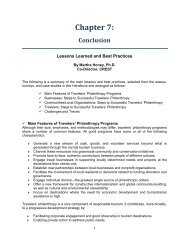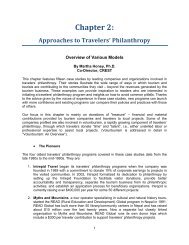Travelers' Philanthropy Handbook - Center for Responsible Travel
Travelers' Philanthropy Handbook - Center for Responsible Travel
Travelers' Philanthropy Handbook - Center for Responsible Travel
Create successful ePaper yourself
Turn your PDF publications into a flip-book with our unique Google optimized e-Paper software.
The Ask ─ Or is it the Offer?By Sam Ham, Ph.D.Department of Conservation Social Sciences, University of IdahoIf I were to summarize in a single sentence the core strategy <strong>for</strong> a travelers’ philanthropycampaign that stands the greatest chances of success, it would be:Develop an experiential product that leads travelers to care about the place, andthen give them an opportunity in the immediate time frame to act on their caring.Caring is at the heart of every philanthropic act, including travelers’ philanthropy. Gifts made inthe absence of caring are usually given with the expectation of a material or otherwise extrinsicreturn of some kind. But the expected reward <strong>for</strong> philanthropic giving is largely intrinsic in thesense that it serves mainly to bring happiness to the donor. I believe that understanding thisdifference is a key to successful “asking.” But there is more to it.Successful travelers’ philanthropy programs target the heart first. Their developers know thatalthough less-philanthropically inclined travelers might also choose to participate, the truephilanthropists are only reachable with a heart-based appeal. Indeed, the sense that happinessis achieved by making a positive difference in the world is at the root of every philanthropic act.If we understand philanthropy as a very self-serving (even “selfish”) behavior we are going to bemore successful in stimulating travelers to give. When people give from the heart, they do notfeel they are sacrificing or giving up anything. Rather they simply feel happy to have been partof something good and important, and many are likely to feel grateful to you <strong>for</strong> giving them theopportunity to do it. From their perspective,your request is perceived not as an “ask” butrather as an “offer.” Recognizing thedistinction between asking and offering isvital to the success of a travelers’philanthropy program.If you feel sheepish about asking yourcustomers to give their money in support oflocal conservation or humanitarian ef<strong>for</strong>ts,you probably haven’t yet convinced yourselfthat you are giving the donor an opportunity<strong>for</strong> happiness. While fundraising andsoliciting philanthropic contributions appearsimilar on the surface, they really are quitedifferent things. From the perspective of the donor, the motivation to contribute philanthropicallyis different from the motivations that drive other types of donations. While many people makecharitable contributions <strong>for</strong> largely philanthropic reasons, other motives (qualifying <strong>for</strong> taxdeductions, peer pressure, social desirability influences, etc.) often are part of their thinking. Inphilanthropy, however, these other influences fade into the background. True philanthropy isbased primarily on the intrinsic motivators of love and caring. Appealing to these motivatorswhen you make your request is almost always a good idea, and will strengthen your ownconviction that your request will be perceived more as an “offer” than as an “ask. When I traintravel operators and guides in developing successful philanthropy campaigns, I stress this141Visitors with Lindblad Expeditions guide,Baja Cali<strong>for</strong>nia, Mexico. Credit: Sam Ham.















